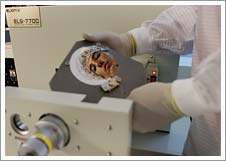
Magnetic Logic
Francis Bacon is credited with saying, “Printing, gun powder,
and the magnet ... these three have changed the whole face and state
of things throughout the world.” Things might be changing again:
A multidisciplinary team in the College of Engineering has received
a $300,000 grant from the National Science Foundation’s Emerging
Models and Technologies for Computation program to study the potential
of lithographically defined nanomagnets within the Quantum-dot Cellular
Automata (QCA) architecture scheme — using nanomagnets for computation.
Michael Niemier (B.S., CPEG ’98; M.S. CSE ’00; and Ph.D.
CSE ’04), research assistant professor of computer science and
engineering; Gary H. Bernstein, professor of electrical engineering;
X. Sharon Hu, associate professor and director of graduate studies
for the Department of Computer Science and Engineering; and Wolfgang
Porod, the Frank M. Freimann Professor of Electrical Engineering and
Director of the Center for Nano Science
and Technology, are investigating
the viability of nanomagnets for signal processing and other applications
by determining if nanomagnets can outperform CMOS systems for a given
set of applications. Initial studies are targeting the environments
most suited for this implementation of the QCA architecture, such as
space and military applications that require very low power and are
tolerant to radiation. Embedded systems will also be considered. Niemier
and Hu are investigating circuit design, system-level architectures,
and performance benchmarking, while Bernstein and Porod are working
to fabricate design components.
In
a related project, documented in the January 13, 2006, issue of Science, another team of University researchers (Porod; Bernstein; Alexei
Orlov, research associate professor; Alexandra
Imre, research associate; and
Lili Ji, graduate student, in conjunction with Gyorgy
Csaba of the
Institute for Nanoelectronics at the Technical University of Munich)
demonstrated magnetic QCA with nanomagnets holding information and
magnetic interactions executing logic functions. This is the next step
in the process toward an all-magnetic information processing system
that uses little or no electricity.
|


